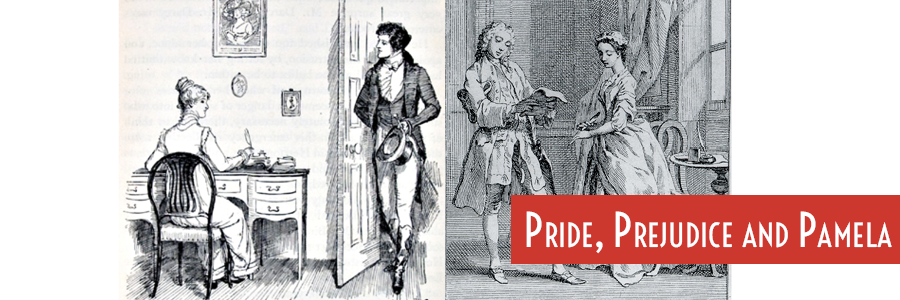In reading Pride and Prejudice, I inevitably found myself still thinking of Pamela, my previous reading, and comparing Austen and Richardson. There are probably many dissertations written about Richardson’s influence on Austen, but I’ll share a few of the things I noticed.
Writing style and characterization
The jump from Richardson to Austen is a big one. After the close POV of Pamela’s epistolary writings, with Austen we are following multiple characters. Elizabeth Bennet is lightyears ahead of Pamela in relatability: she’s not so insufferably virtuous, she has her pride and prejudicial character faults which help the reader to identify with her as a person. Likewise, I found Darcy far more likable than Mr B. When Darcy is viewed as a jerk by others in the early part of the book, the narrative makes it obvious that he’s not really proud, he’s just introverted. (I suspect he also has resting bitch face.) Over time Elizabeth comes around to the view that the reader has had for a while: Darcy’s actually a pretty good guy. That’s almost directly opposite from the arc taken by Pamela and Mr. B: at the opening of the story the reader and Pamela both see that Mr B is, as she puts it, “naughty.” As the story continues, Pamela comes to profess admiration and love for Mr B, but the narrative makes it obvious he is still a sack of shit who hasn’t undergone the believable character growth which Darcy does.
The two heroes have similar character arcs: each is put off the idea of matrimonial bonds with heroine by her lower social status but are eventually persuaded that the heroine’s virtues outweigh her low connection. Both men initially assume their attentions will be welcomed and are therefore angry when they are rejected, but their reactions are entirely different.
- Mr B kidnaps Pamela and holds her until Stockholm syndrome sets in. Pamela valiantly defends her virtue until Mr B realizes the only way under her skirts is through a wedding ring.
- Darcy, after his marriage proposal is rejected, writes a letter of explanation on factual matters and then leaves without pressing his suit further on Elizabeth. Without expecting to see her again, he alters his behaviors based on her criticisms of his character.
(Darcy wins in this contest.)
Austen callbacks to Richardson
In listening to The History Chicks’ podcast episode on Jane Austen, they mentioned that Richardson’s other book, Clarissa, was a favorite of Austen’s. This is the only thing that makes me consider picking up that one, which is even longer than Pamela. I expect we can take it for granted that she had also read Pamela, which made me wonder a bit about the character of Mr. Collins. He likely represents many contemporary subtleties that escape me, but I did wonder if he was meant in any way to act as a parody of Richardson. Mr. Collins’ letter after Lydia runs off with Wickham was particularly Pamela-esque:
The death of your daughter would have been a blessing in comparison of this.
Compare to the early advice of Pamela’s father:
We had rather see you all covered with rags, and even follow you to the churchyard, than have it said, a child of ours preferred any worldly conveniences to her virtue.
Lydia definitely prefers worldly conveniences to her virtue. And she goes with Wickham, who could have been a parson under Darcy’s patronage. During Pamela’s trials she attempts to enlist the help of the parson Mr. Williams, who is under Mr B’s patronage. Williams subsequently loses Mr B’s favor and is an object of the gentleman’s intense, though unfounded, jealousy. So it’s interesting to see that Wickham, who was meant to be a parson under Darcy’s patronage, was briefly an object of Elizabeth’s attentions.
Use of secondary characters
I saw a certain similarity in the two authors’ use of the secondary characters. Although Austen doesn’t shove it in your face like Richardson does, many of her characters can be read as didactic examples.
Jane is sweet and sees the best in everyone. She gets happily married. Be like Jane.
Lydia is a flibbertigibbet who never learns and she ends married to a disreputable man who soon tires of her. Don’t be like Lydia.
Charlotte was on the shelf but she grabbed the opportunity in front of her and ended up with Mr Collins. Ummm… at least from the 21st century view, don’t be like Charlotte.
You probably don’t want to be like Mr and Mrs Bennet, marrying in haste and repenting at leisure. (At least, at Mr Bennet’s leisure.) Don’t be vulgar like Mrs Philips, either, or be a meddling and overbearing personage like Lady Catherine. Take care of your own affairs; there is no need to micromanage everyone else’s.
Take Elizabeth’s example and do you, or take Darcy’s example and take criticism constructively and you may have a chance at happiness. I’d say Austen’s failure to list everyone’s lessons learned at the end of the book is a major part of what makes her so superior to Richardson, but maybe I’m still a little traumatized by Pamela.
Lady Catherine coming to upbraid Elizabeth at the end also makes an interesting parallel with Pamela’s excoriation by her new sister-in-law Lady Davers. Both are the closest female relation to the hero, both have other brides in mind, neither scruples to tell the heroine that she’s fighting above her weight class. And in turn, both Pamela and Elizabeth defend themselves with some wonderfully sharp remarks. Ultimately, of course, the female relative is overruled, and the hero unites with his chosen partner and damn the family and social opinions.
That’s all I’ve got on Pride and Prejudice right now: next week I’ll be moving on to Jane Eyre, the ultimate November romance read!



